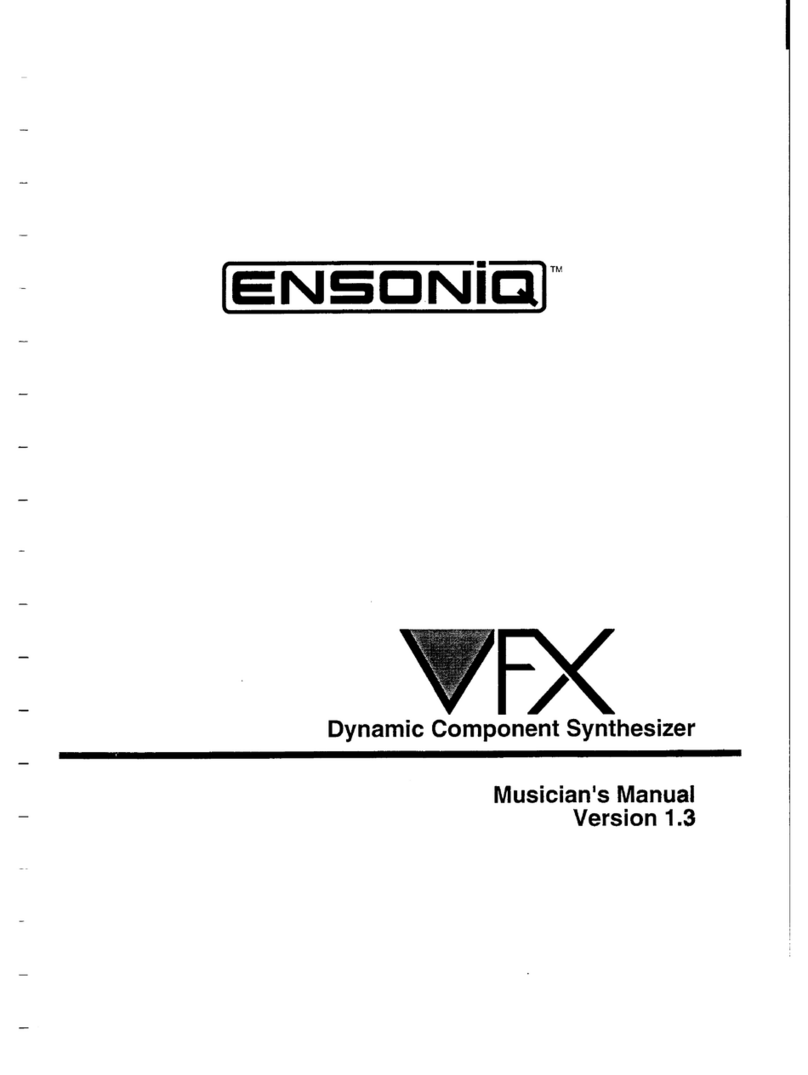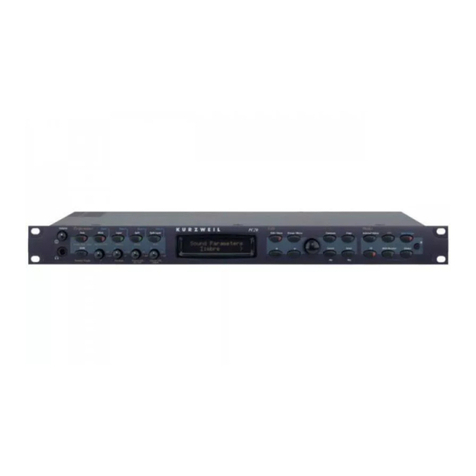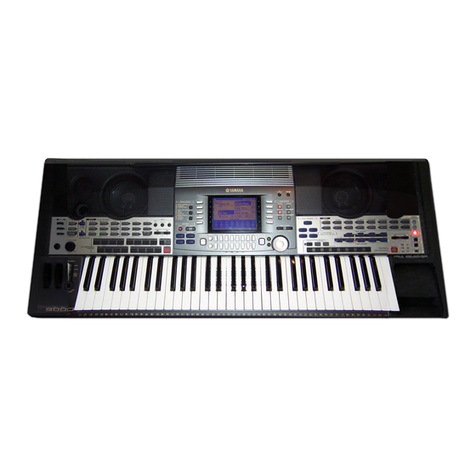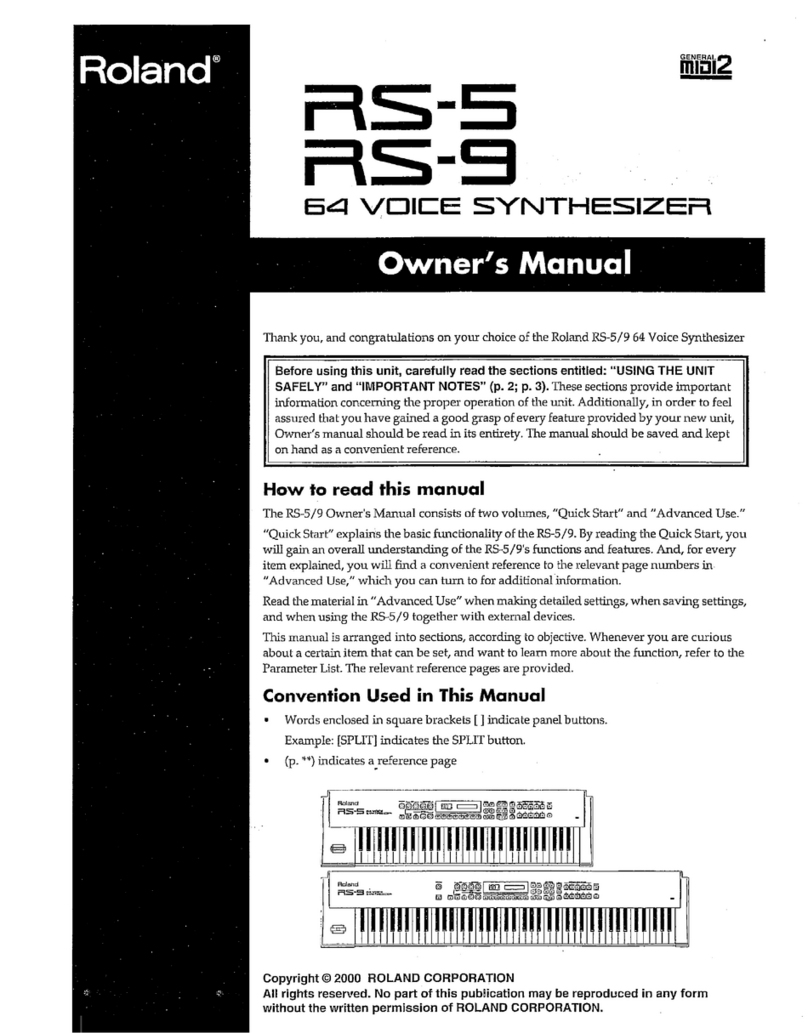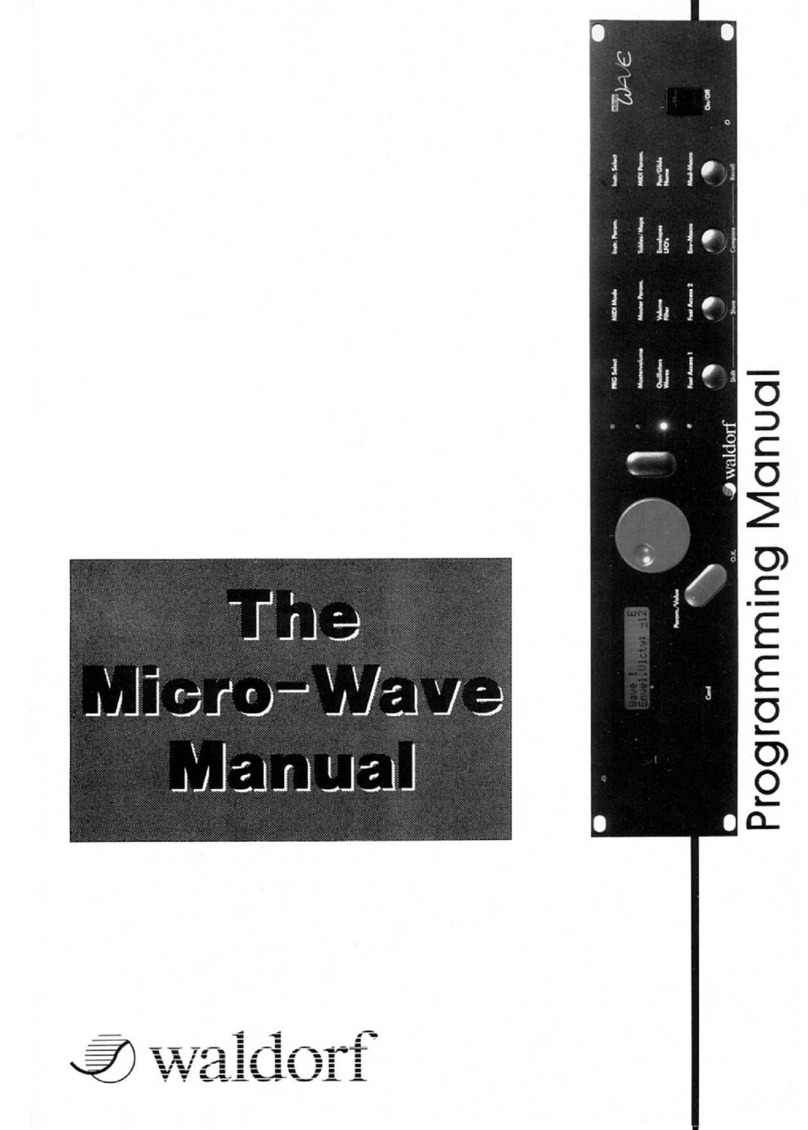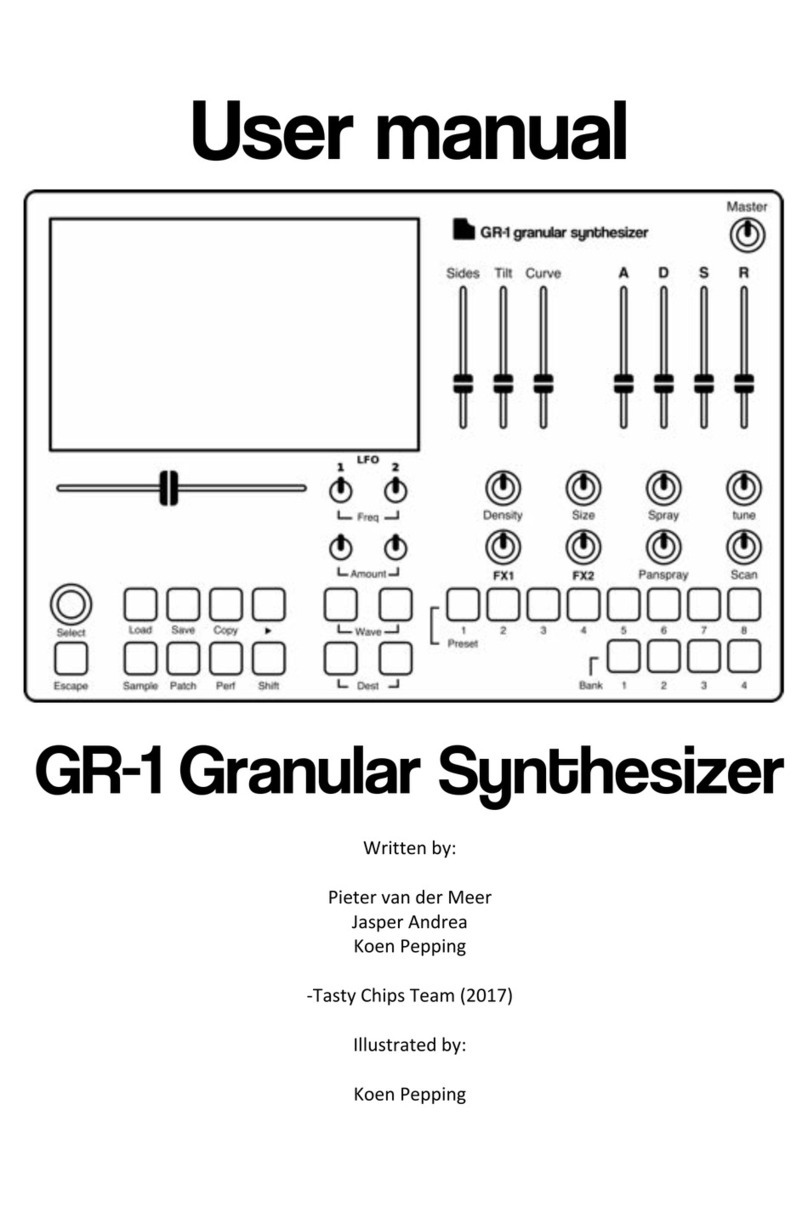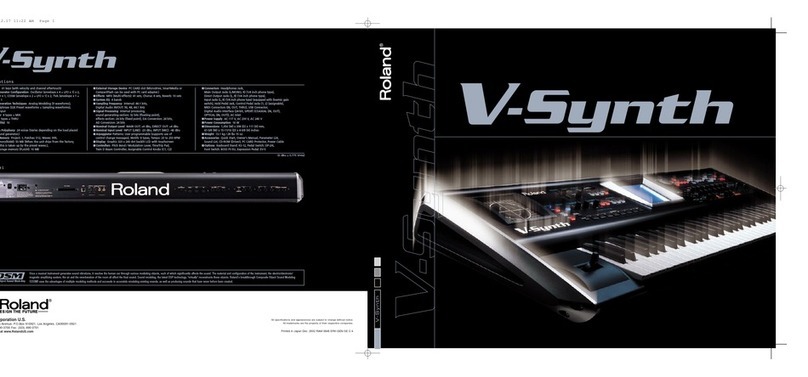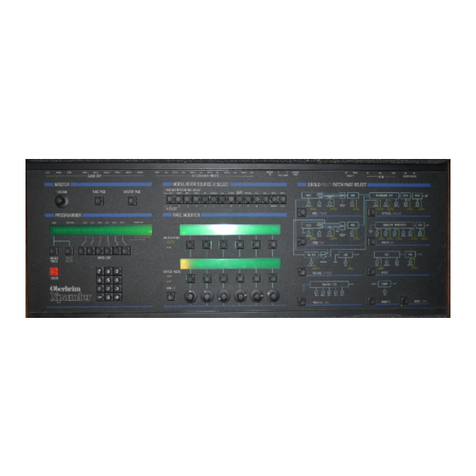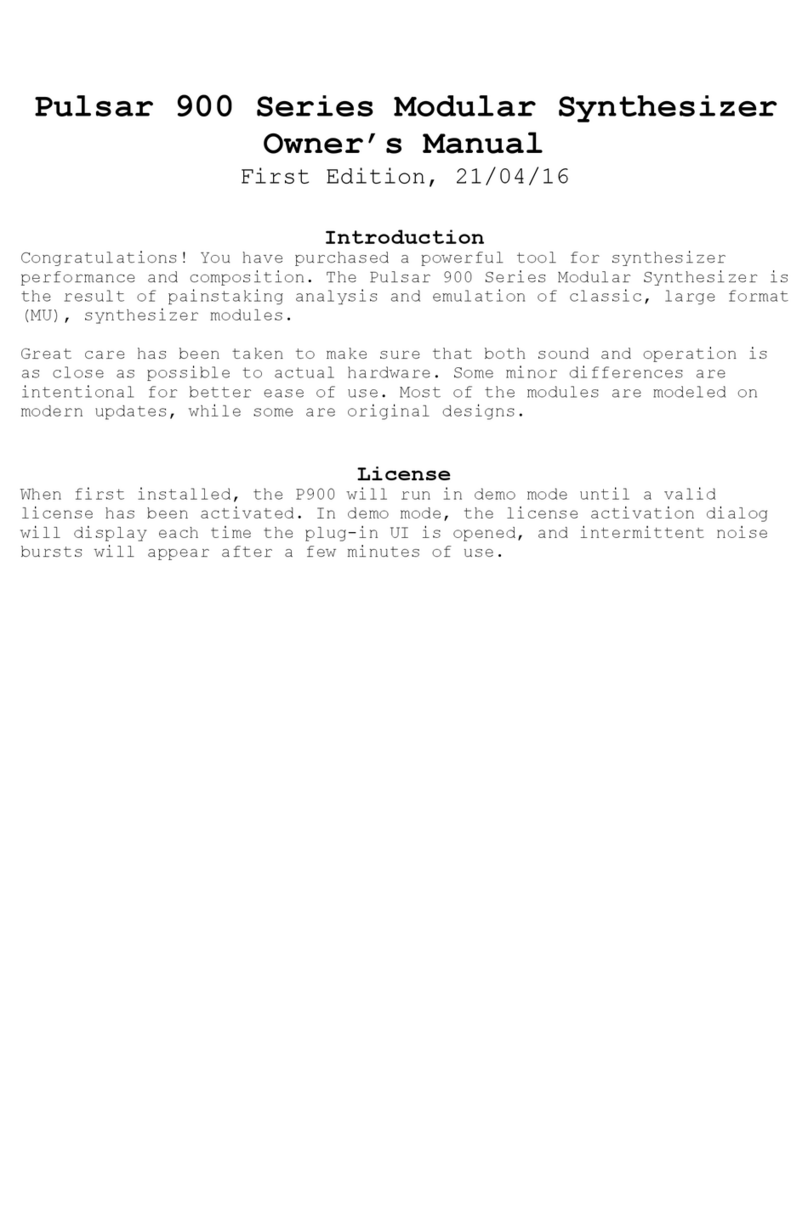Instruo Ts-L User manual

Tš-L
Oscillator
User Manual

2
Contents
3
Description / Features
4
Installation / Specifications
5
Overview
6
Waveforms
7
Frequency / Pitch
8
Pulse Width Modulation
9
Frequency Modulation
10
Wavefolding
11
Soft Syncronistation / Phase Locking
12
Patch Examples

3
Description
The Instruō Tš-L is a fully analogue voltage controlled oscillator with a
plethora of features in a very small footprint.
Its triangle core circuitry allows for extremely consistent waveforms over
a wide frequency range. The triangle foundation is used to generate its
sine waveform which holds consistent shape and amplitude across Tš-L’s
wide range. The outputs consist of simultaneous Square/Sub, Triangle,
and Sine waveforms, with an additional voltage controllable wavefolder
and a complex PWM waveshaper.
Tš-L includes every feature needed to powerfully perform as a rich,
ultra-compact audio source, as well as functioning equally as a versatile
modulation source.
Features
• 1V/Oct tracking
• Linear and exponential frequency modulation
• Pulse width modulation
• Wavefolding
• Soft synchronisation
• Sub-square mode

4
Installation
1. Confirm that the Eurorack synthesizer system is powered off.
2. Locate 6 HP of space in your Eurorack synthesizer case.
3. Connect the 10 pin side of the IDC power cable to the 2x5 pin
header on the back of the module, confirming that the red stripe on
the power cable is connected to -12V.
4. Connect the 16 pin side of the IDC power cable to the 2x8 pin
header on your Eurorack power supply, confirming that the red
stripe on the power cable is connected to -12V.
5. Mount the Instruō Tš-L in your Eurorack synthesizer case.
6. Power your Eurorack synthesizer system on.
Note:
This module has reverse polarity protection.
Inverted installation of the power cable will not damage the module.
Specifications
• Width: 6 HP
• Depth: 35mm
• +12V: 60mA
• -12V: 40mA

5
CO
ARSE
ARSE
FINE
1V/OCT
S
YNC
FM
SUB
PW
M
SY
MMETR
Y
CV
PULSE
FOLD
LIN
EXP
T
š-L
Tš-L ti-əz-εl proverb (siri) “this sauce later rocks”
Key
1. Square Output
2. Sub Toggle
3. Triangle Output
4. Sine Output
5. PWM Output
6. Wavefold Output
7. Coarse
8. Fine
9. 1V/Oct Input
10. PWM CV Input
11 . PWM CV Attenuverter
12. PWM Waveform Crossfade
13. FM Input
14. FM Attenuator
15. Lin/Exp Toggle
16. Wavefold CV Input
17. Wavefold Depth / CV Attenuater
18. Symmetry Bias Attenuverter
19. Soft Sync Input
5 6
14
7
8
9
11
10 16
12
13 14
15
17
18
2
19
3

6
Waveforms
Square Output: Square waveform output.
Sub Toggle: The Sub Toggle determines the octave of the
square waveform.
• If the toggle is set to the right position, the frequency of the square
waveform is set to one octave below the fundamental frequency of
the oscillator.
• If the toggle is set to the left position, the frequency of the square
waveform is set to two octaves below the fundamental frequency of
the oscillator.
Triangle Output: Triangle waveform output.
Sine Output: Sine waveform output.
Pulse Output: Pulse width modulation waveform output.
• This waveform is unlike any other. It smoothly morphs from a split
triangle waveform to a slightly softened stepped triangle waveform.
Wavefold Output: Final waveform output.
• The waveform is determined by the Wavefold Attenuator and the
Symmetry Bias parameter.
SPLIT TRIANGLE STEPPED TRIANGLE

7
Frequency/Pitch
Coarse: The Coarse knob controls the fundamental frequency of the
oscillator. It determines the pitch of all waveforms.
• Turning the knob anticlockwise will decrease the frequency.
• Turning the knob clockwise will increase the frequency.
Fine: The Fine knob is used for minute control of the oscillator’s
fundamental frequency and is relative to the frequency value set by the
Coarse knob. This will also determine the pitch of all waveforms.
• Turning the knob anticlockwise will decrease the frequency.
• Turning the knob clockwise will increase the frequency.
1V/Oct Input: The 1V/Oct Input is a bipolar control voltage input that
is calibrated to 1 volt per Octave.
• This is traditionally used for frequency control (musical pitch) sent
from a sequencer or keyboard.
• Control voltage is summed with the values set by the Coarse and
Fine knobs

WAVESHAPE
CONTROL POSITIONS
8
Pulse Width Modulation
PWM: The PWM parameter controls the width of the pulses for the PWM
waveform.
• Turning the knob anticlockwise will decrease the width of the pulses.
• Turning the knob clockwise will increase the width of the pulses.
PWM CV Input: The PWM CV Input is a bipolar control voltage input for
the PWM parameter.
• Control voltage is summed with to the PWM knob position.
• Input range: –/+5V.
PWM Waveform Crossfade: The PWM Waveform Crossfade knob
controls the blend between two parallel PWM controlled waveforms
produced by Tš-L.
• Turning the knob anticlockwise will blend towards the split
triangle waveform.
• Turning the knob clockwise will blend towards the stepped
triangle waveform.

9
Frequency Modulation
FM Input: The FM Input is a bipolar control voltage input for the
frequency parameter of the oscillator.
• Control voltage is summed with the values set by the Coarse and
Fine knobs and scaled by the FM Attenuator.
FM Attenuator: The FM Attenuator determines the depth of frequency
modulation applied to the fundamental frequency.
• Turning the knob anticlockwise will decrease the depth of
frequency modulation.
• Turning the knob clockwise will increase the depth of
frequency modulation.
Lin/Exp Toggle: The FM Input can be set to have a linear or
exponential FM response curve.
If the toggle is set to the left position, the FM
signal will apply with linear scaling.
If the toggle is set to the right position, the FM
signal will apply with exponential scaling.
• If the toggle is set to exponential FM and the FM Attenuator is fully
clockwise, the FM Input will essentially track at 1V/Octave (Its
tracking may differ slightly from the calibrated 1V/Oct Input).
LIN EXP

10
Wavefolding
Wavefold: The Wavefold knob controls the amount of wavefolding
applied to the waveform produced at the Wavefold Output.
• A parallel sine waveform is used by the wavefolder.
• Turning the knob fully anticlockwise results in a waveform that
resembles a sine waveform.
• Turning the knob fully clockwise results in a rich, harmonic timbre
(Adjusting the Symmetry Bias knob will further affect the
harmonic makeup).
Wavefold CV Input: The Wavefold CV Input is a unipolar positive
control voltage input that can be scaled by the Wavefold knob.
• When external control voltage is used to control the wavefolder, the
Wavefold knob becomes an attenuator over the external control
voltage signal.
Symmetry Bias: The Symmetry Bias knob controls a DC offset amount
that shapes the sine waveform used by the wavefolder. The amount of
DC offset is applied before the wavefolding stage.
• The Symmetry Bias parameter offsets the curvature of the raw sine
waveform that becomes further shaped by the wavefolder.
• Applied Symmetry Bias will affect the harmonic makeup of the
final waveform.

11
Soft Synchronisation/Phase Locking
• Soft Sync Input: Tš-L implements Soft Synchronisation.
• This is also known as Frequency Lock or X-Lock.
• The oscillator’s core triangle waveform changes its charge direction
when clocked.
• When tuning the oscillator to an external signal, the Soft Sync Input
can be used to phase lock the signals to remove beat frequencies in
unison and perfect interval tunings.
• Tš-L will lock to integer multiples of the external signal.
• Musical intervals such as perfect octaves, perfect 4ths, and perfect
5ths work best for the Soft Sync Input.
• Voltage threshold: 2V.

12
Patch Examples
East Coast Synth Voice:
Summary: The sequencer or keyboard sends voltages to Tš-L while
simultaneously triggering the envelope generator. The CV output of the
envelope generator opens the filter and VCA, allowing Tš-L’s signal to
pass through. More traditional East Coast patches would incorporate
separate envelope generators for the filter and VCA.
Audio Path:
• Connect the Square, Pulse, and Triangle waveforms of Tš-L to three
inputs of a mixer.
• Set the Sub Toggle to its left position, dropping the square waveform
by one octave.
• Connect the output of the mixer to the audio input of a filter.
• Connect the audio output of the filter to the audio input of a VCA.
• Monitor the output of the VCA.
1V/Oct Signal
Gate Signal
Output

13
• Set the fundamental frequency of Tš-L to a desired position.
• Set the individual levels of the mixer to desired positions.
• Set the cutoff frequency of the filter to a desired position.
• Set the resonance of the filter to a desired position.
• Set the level of the VCA to a desired position.
Control Path:
• Connect the 1V/Oct output of a sequencer or keyboard to the
1V/Oct input of Tš-L.
• Connect the gate output of the sequencer or keyboard to the trigger
input of an envelope generator.
• Connect the CV output of the envelope generator to a multiple.
• Connect one copy of the envelope generator CV signal to the CV
input of the filter and set the corresponding CV attenuator to a
desired position.
• Connect a second copy of the envelope generator CV signal to the
CV input of the VCA and set the corresponding CV attenuator to a
desired position.
• Set the envelope stages to desired positions.

14
FM Synth Voice:
Summary: The secondary oscillator, called the Modulator in an FM
patch, is modulating the frequency of Tš-L, called the Carrier in an
FM patch. The sequencer or keyboard sends voltages to Tš-L while
simultaneously triggering the envelope generator. The CV output of the
envelope generator opens the filter and VCA, allowing Tš-L’s signal to
pass through. More traditional East Coast patches would incorporate
separate envelope generators for the filter and VCA.
Audio Path:
• Create an East Coast Synth Voice audio path using the sine
waveform of Tš-L.
Control Path:
• Create an East Coast Synth Voice control path.
• Connect the sine waveform of a separate oscillator to the FM Input
of Tš-L.
1V/Oct Signal
Sine wavefrom
Gate Signal
Output

15
• Set the FM Attenuator to a desired position.
• Set the Lin/Exp Toggle to a desired position.
• Most East Coast synthesizers were traditionally limited to linear
frequency modulation only.

16
Folded PWM Synth Voice:
Summary: Connecting the PWM Output to the Wavefold CV Input
allows for four levels of timbre control via the PWM knob/PWM CV
Input, the PWM Waveform Crossfade knob, the Wavefold knob, and
the Symmetry Bias knob. The sequencer or keyboard sends voltages
to Tš-L while simultaneously triggering the envelope generator. The CV
output of the envelope generator opens the filter and VCA, allowing
Tš-L’s signal to pass through. More traditional East Coast patches would
incorporate separate envelope generators for the filter and VCA.
Audio Path:
• Create an East Coast Synth Voice audio path using the Wavefold
Output of Tš-L.
• Set the Wavefold knob to a desired position.
• Set the Symmetry Bias knob to a desired position.
1V/Oct Signal
Gate Signal
Output

17
This device meets the requirements of the following standards: EN55032,
EN55103-2, EN61000-3-2, EN61000-3-3, EN62311.
Manual Author: Collin Russell
Manual Design: Dominic D’Sylva
Control Path:
• Create an East Coast Synth Voice control path.
• Connect the Pulse Output to the Wavefold CV Input.
• Set the PWM knob to a desired position.
• Set the PWM Waveform Crossfade knob to a desired position.
Table of contents
Other Instruo Synthesizer manuals

Instruo
Instruo Dual Looper User manual
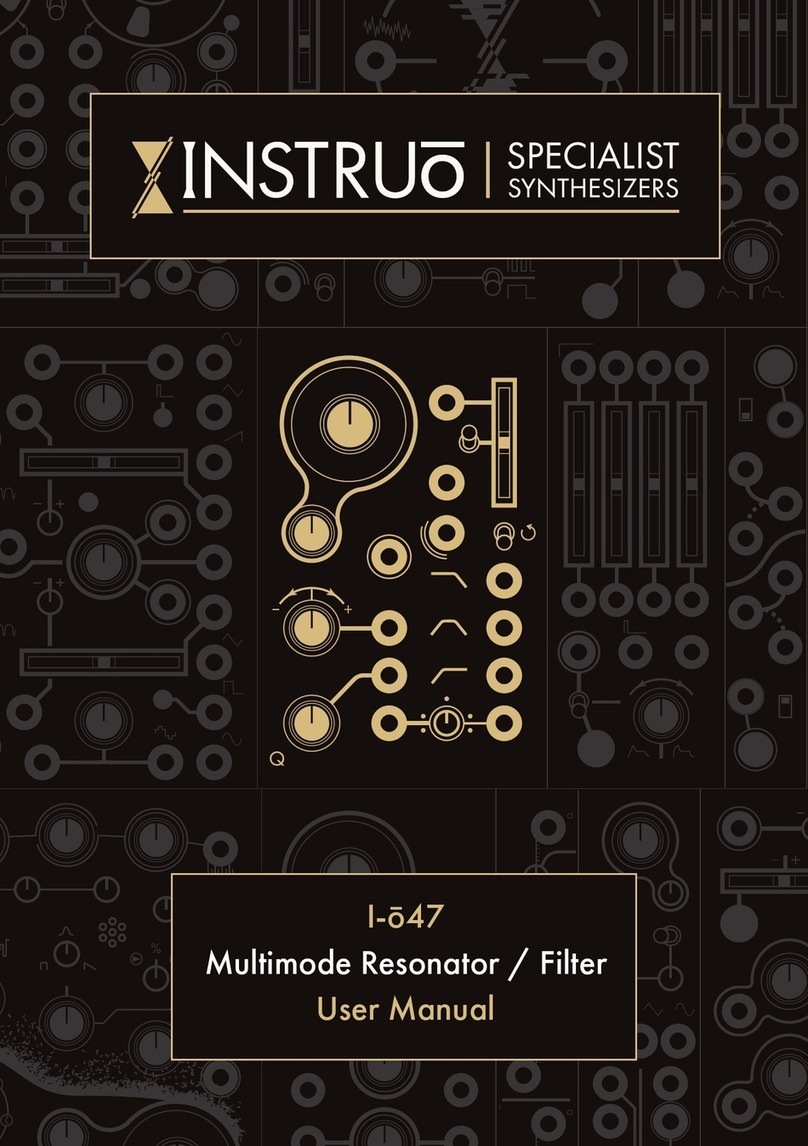
Instruo
Instruo I-o47 User manual
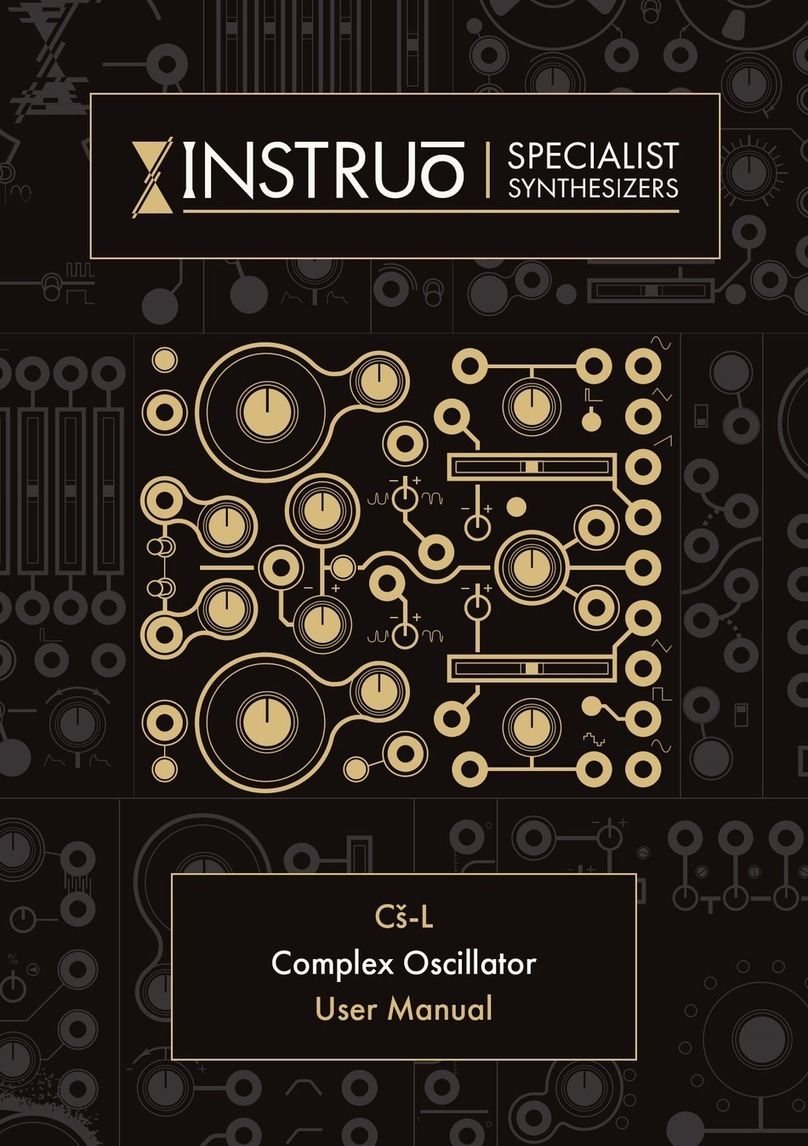
Instruo
Instruo Cs-L User manual
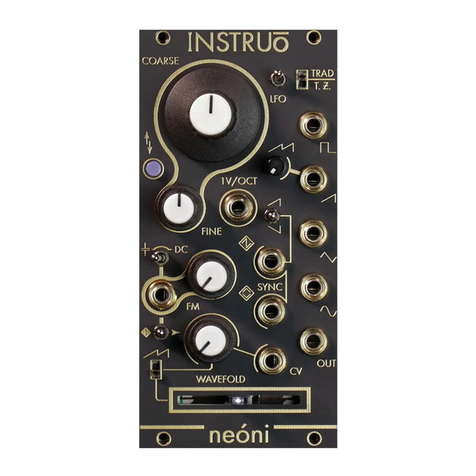
Instruo
Instruo Neoni User manual

Instruo
Instruo ceis User manual
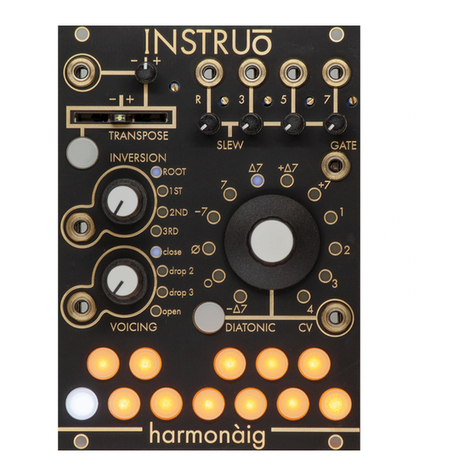
Instruo
Instruo harmonaig User manual
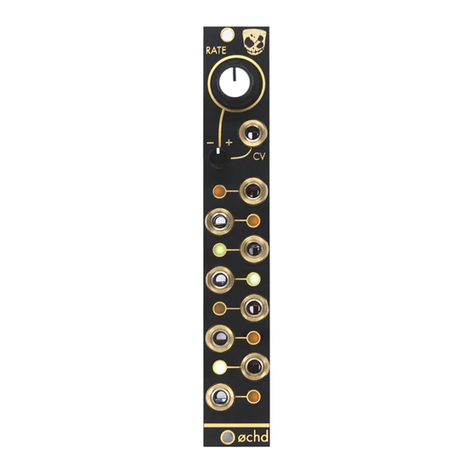
Instruo
Instruo OCHD LFO User manual
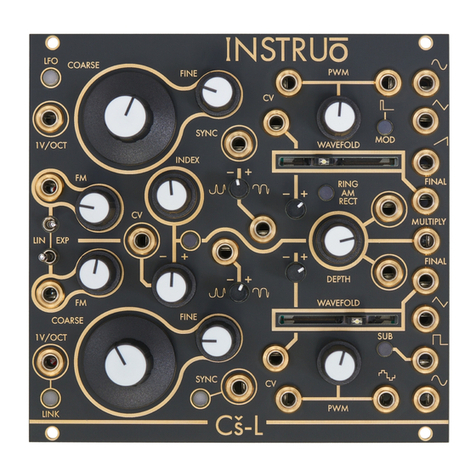
Instruo
Instruo Cs-L User manual
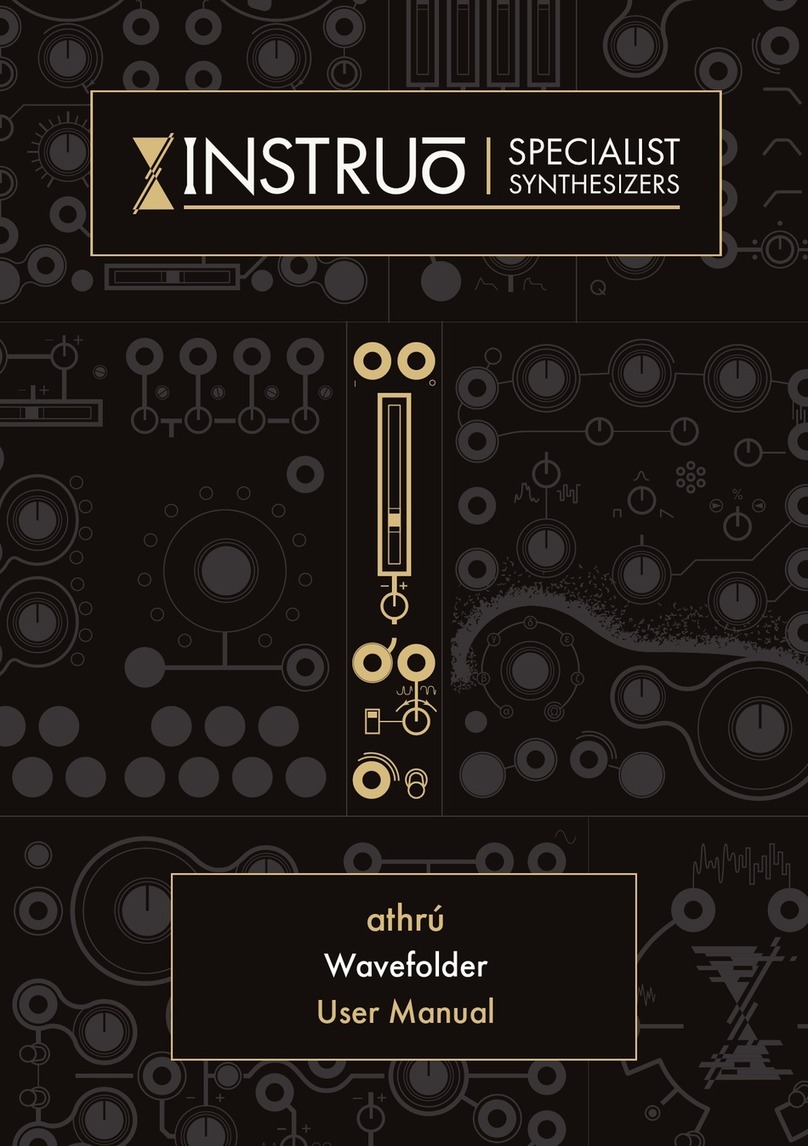
Instruo
Instruo athru User manual

Instruo
Instruo Tagh User manual



